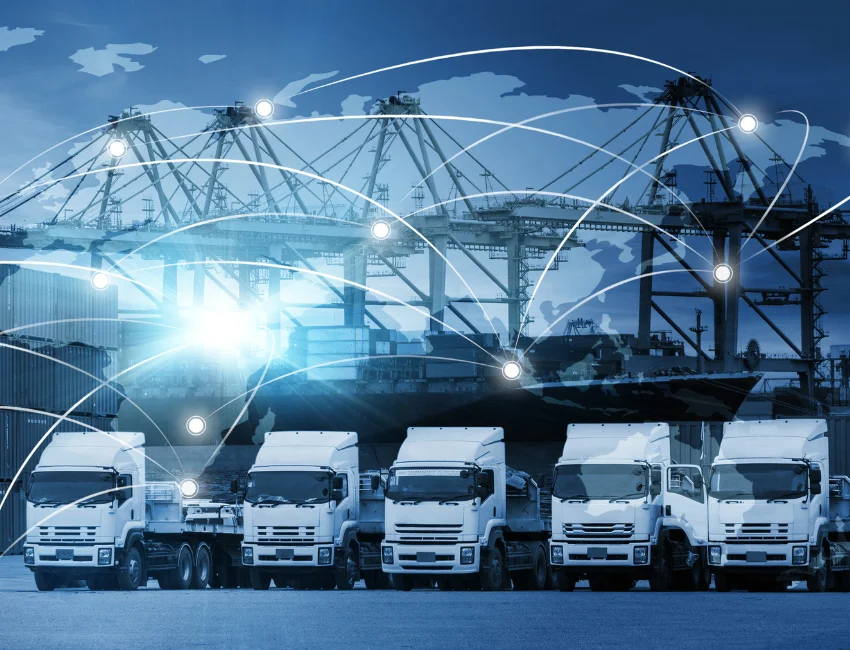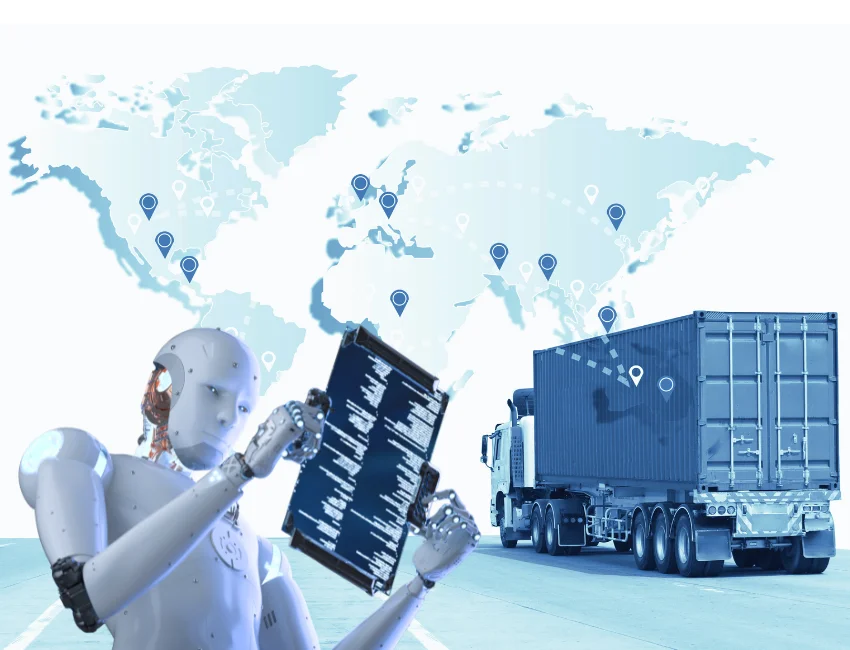

AI in transportation and logistics improves by optimizing delivery routes, predicting demand, reducing fuel costs, and automating warehouse operations. Machine learning enables real-time tracking, while predictive analytics enhances supply chain planning and inventory management. These innovations increase speed, accuracy, and cost-efficiency across the logistics sector.
We transport goods and people using new methods today, and it is clear that Artificial Intelligence is at the core of it all. AI is now part of every logistic system as it helps businesses achieve new milestones concerning speed, safety, and accuracy.
From self-driving trucks to live traffic predicting systems, AI has found numerous applications in transportation. There is no doubt: whether it concerns last-mile delivery or cross-country freight shipping, AI and transportation are interdependent.
This transformation is not reserved for technological beacons. AI is being adopted by businesses of all sizes across the world to tackle the age-old problem of delays, rising fuel prices, and low efficiency. Fuel consumption is being optimized by implementing intelligent routing strategies coupled with refined delivery tracking systems.
In this blog we will provide insights into the use of AI in transportation and logistics, current implementations of AI technology, and speculate on the future of AI mobility.
Let’s be honest: The speed and scale of today’s society is impossible to match with old paper logs, manual planning, and sluggish decision-making. With AI transportation technologies available, logistics can be optimized in real-time instead of having to wait and repeatedly fine-tune.
AI systems improve accuracy by analyzing extensive data sets that include weather forecasts, GPS signals, and fuel usage, among others. Each analyzed data set helps AI to make better decisions and learn to improve performance. This demonstrates why transportation AI is transformative technology: it proactively adapts to autonomous improvements, real-time changes, and boosts efficiency with every delivery.
AI in transportation encompasses almost all aspects of the journey including: everything from fleet tracking, route planning, to traffic management and predictive maintenance.

AI is more than a trending phrase; it’s embedded in day-to-day activities. Let’s take a look at how AI in transportation and logistics works in real-time, and how is AI used in transportation.
Dynamic route planning is a clear illustration of AI’s impact on transportation. Real-time traffic monitoring and weather updates ensure drivers take the most efficient routes.
Transportation AI is able to make real-time route adjustments, which are critical for delivery platforms and ride-hailing services. This results in effective fuel utilization. There are systems that adjust real-time based on customer location or other unforeseen disruptions. This also helps elevate customer experience.
The concept of self-driving trucks and AI delivery bots may seem far-off. But they’re currently undergoing trials. And some have even been deployed. These systems combine sensors, and AI models to automate navigation on roads. This helps avoid collisions, and manage stops.
In even the most semi-autonomous models, AI assists drivers with lane-keeping. Besides that, it supports cruise control, and obstacle detection for ensuring safety and reduced driver fatigue.
Operations can be stalled and costs can skyrocket due to unexpected vehicle breakdowns. Transport companies can use AI to analyze sensor data in real-time to predict issues to mitigate using sensors.
For instance, AI can keep track of an engine’s temperature, a tyre’s pressure, brake wear, and fuel consumption. If something appears amiss, the maintenance team is alerted, which mitigates costs and downtime.
AI can control the flow of traffic using real time data from traffic cameras, constituents, IoT devices, and vehicle GPS. City planners and private companies can change their routes optimized for congestion mitigation as well as expedited delivery.
AI transportation devices that visualize vehicle locations and monitor driver behavior help fleet management teams mitigate inter-team coordination issues, leading to overall better task execution.
The contemporary customer expects deliveries to be fast, reliable, and traceable. AI systems assist by combining all the relevant data such as orders, inventory levels, available delivery slots, and even traffic into a single system.
As a result, fulfillment and delivery rates improve, package communication is streamlined, and AI aids in package loss reduction. Additionally, AI forms backup plans when contingencies arise, for instance, providing different routes when there are closed roads or other delays.
Let’s review some of the companies leveraging AI in transportation market to enhance their operational effectiveness.
UPS leverages AI for route planning, sorting packages, and even anticipating delays in service. Their ORION system is said to save millions of miles and gallons of fuel each year by learning and adapting routes based on delivery conditions.
Some of the most advanced uses of AI technology in transportation are found in the Autopilot and Full Self Driving features of Tesla vehicles. Tesla vehicles utilize neural networks to progressively drive more safely and efficiently, which aids in the autonomous mobility revolution.
Ryder is a major fleet management company that employs AI for monitoring vehicle health, advancing driver safety protocols, and fuel usage reduction. Their dashboards provide real-time performance updates alongside actionable insight.
An intricate system of AI and robotics powers Amazon’s delivery operations. Robots facilitate movement within the warehouses, AI handles the scheduling of deliveries, and Amazon guarantees accurate and punctual delivery of packages to customers.

What, precisely, are the business benefits? Here is a careful investment in AI for transportation and its most crucial advantages:
AI greatly improves the time between delivery and shipping thanks to intelligent routing, tracking of vehicles, and faster operations in the warehouse.
With predictive maintenance, optimized routes, and less fuel being consumed, the fleets incur significantly reduced expenses because of less-needed repairs.
AI enables great problem anticipation for things like traffic-jams or imminent equipment failures in parts where necessary. Because things can be acted upon quickly, smooth workflows are sustained.
Fatigue monitoring and smart brakes are just some of the factors AI-enabled technologies bring forth that lead to reducing accidents and making driving safer for operators and other road users.
AI streamlines fuel saving by establishing the best possible driving habits, suggesting the need for an electric vehicle if that’s not met. This makes AI-enabled machines usable where necessary. This leads to lesser carbon footprints.
As with every other sector, the incorporation of AI tech into transport and logistics does present unique challenges:
These complexities—while very real—can be solved with a proper deep dive analysis and technical guidance.
AI will be the impetus driving change in transportation for the next decade and in turn, evolving it more than ever before. there are many examples for the same.
Here’s what to expect:
At WebOsmotic, we design sophisticated AI solutions geared toward helping transportation and logistics companies operate more effectively. From managing local delivery fleets to overseeing global logistics supply chain networks, we equip businesses with AI tools capable of:
WebOsmotic envisions a world where freight, public transit, and eCommerce logistics work together seamlessly, and helps businesses operate faster, safer and more intelligently. Our special AI services can’t be matched!
AI applications in the transportation sector are no longer a futuristic concept, but the backbone of modern logistics technology. Businesses can now move goods with unmatched efficiency, utilizing advanced AI capabilities for smart routing, predictive maintenance, and enhanced real-time visibility.
If you’ve been asking yourself what the use of AI in transport is, the answer is: in every aspect. From smooth sailing bypassing of traffic by drivers to enabling full automation of vehicles, AI and transportation have been intertwined.
If you wish to capitalize on these opportunities, WebOsmotic is ready to be at your service. Together, we can create a transport system which is not simply faster, but more intelligent as well.